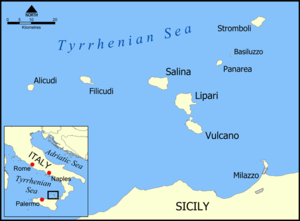Naval Battle of Mylae (260 BC)
| date | 260 BC Chr. |
|---|---|
| place | Coast off Mylae in Sicily |
| output | Roman victory |
| Parties to the conflict | |
|---|---|
| Commander | |
|
Gaius Duilius ( Consul ) |
|
| Troop strength | |
| about 130 ships | about 120 ships |
| losses | |
|
unknown |
unknown |
Agrigento - Mylae - Aeolian Islands - Sulci - Tyndaris - Cape Ecnomus - Aspis - Adys - Tunes - Cape Bon - Panormus - Drepana I - Drepana II - Aegatic Islands
The naval battle of Mylae was the first naval battle between Carthage and the Roman Republic in the First Punic War in 260 BC. . AD before the city Mylae (Greek: Mylae today Milazzo ) on the north coast of Sicily called, won a decisive victory in the Rome.
prehistory
After the battle of Agrigento in 261 BC. The Roman Republic had enough self-confidence to seek war with Carthage at sea as well. With this aim in mind, Rome built a fleet of around 150 ships, quinqueremes and triremes , based on the model of a stranded Carthaginian warship , in the record time of two months. The patrician Gnaeus Cornelius Scipio , Senior Consul of the Year, took command of the first 17 completed ships that were built in Messana and launched in preparation for the landing of the fleet in Sicily. However, he was ambushed ( Battle of the Aeolian Islands ) and lost his entire fleet without a fight.
A short time after this incident, the junior consul Gaius Duilius and the rest of the fleet sought to meet the Carthaginians. As a sea power of many years, Carthage had the experience and knowledge, while the Romans had the newly invented corvus on the bow of their ships, a boarding bridge that was supposed to outweigh the advantages of the Carthaginians.
The battle
The fleets met off the coast at Mylae, and at the beginning of the battle 30 Punic ships, including the flagship , were captured by Roman soldiers with the help of the corvi . Hannibal Gisko , the Punic admiral, was forced to flee in extremis (English: in the face of death) in a small boat in order to get on another of his ships. He tried to outmaneuver the Romans, attack them from the stern and thus be safe from the corvi , but was devastated.
consequences
After the battle, the first great sea victory of the Romans, Gaius Duilius was celebrated as a hero. The consul celebrated a triumphal procession during which he carried the ramming spurs (rostra) of the Carthaginian ships with him, which were then used to decorate the honorary column ( Columna rostrata ) erected for him in the Roman Forum . Duilius was later no longer active in the military, Hannibal Gisko was later commissioned with the defense of Sardinia and there in 258 BC. After his defeat against the consul Gaius Sulpicius Paterculus in the battle of Sulci crucified by dissatisfied subordinates .
literature
- Adrian Goldsworthy : The Fall of Carthage. The Punic wars, 265-146 BC. Reprinted edition. Cassell Military, London 2004, ISBN 0-304-36642-0 .
Individual evidence
- ↑ Jona Lendering: Hannibal (3) on livius.org (accessed May 11, 2010)
